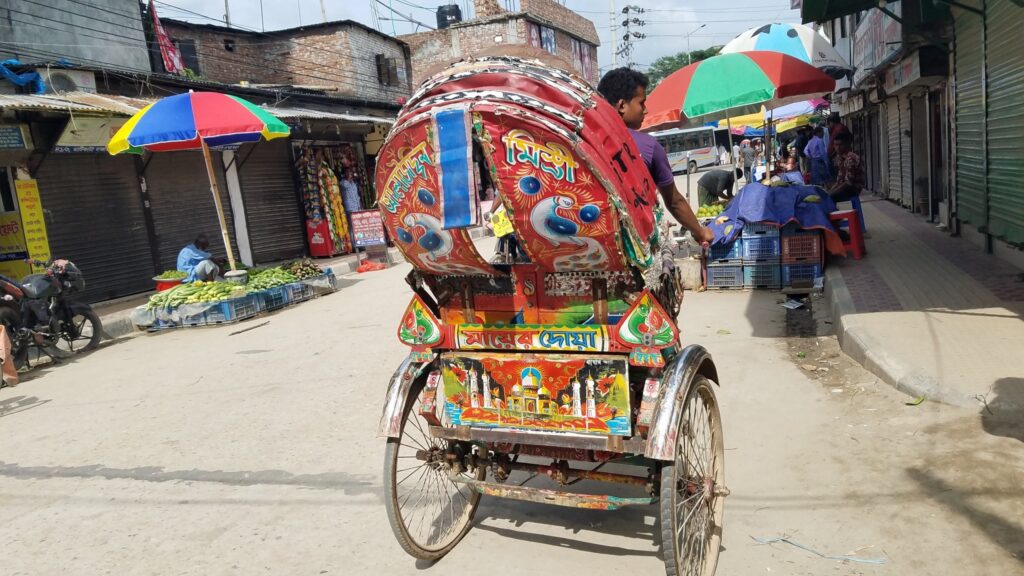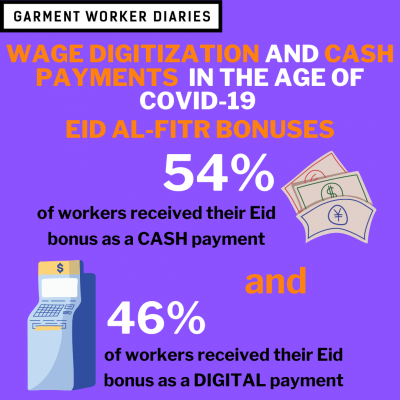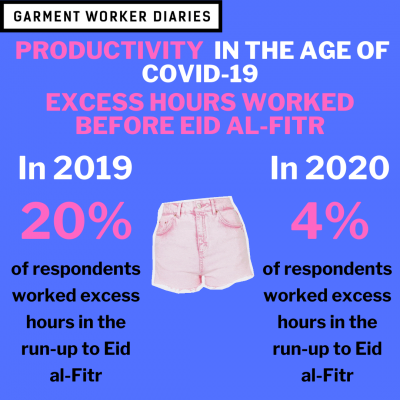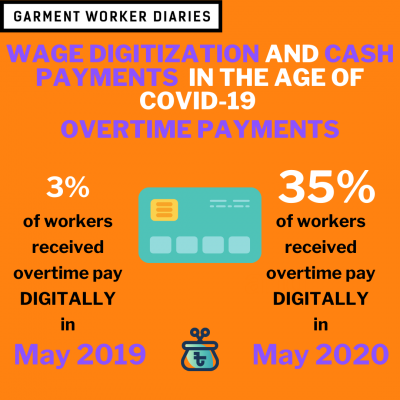In the past nine weeks MFO and SANEM have been tracking the economic transactions of garment workers. In that time we have seen a dramatic increase in digital payments to workers in the ready-made garment sector in Bangladesh. In April 2020, 28% of workers reported that they were being paid digitally, and by May 2020 this share had increased to 82%. By comparison, only 15% of garment workers were paid digitally this same time last year.
However, cash has persisted to be the basis of pay for other factory income, including overtime and the traditional bonus for Eid al-Fitr, which was celebrated on May 25th in Bangladesh this year. We aren’t yet certain what this mix of digital and cash payments will mean for garment workers. But let’s take a closer look at what the data reveal, as told to us by the garment workers themselves.
Eid Bonuses
Most garment workers receive a bonus payment from their factory in addition to their salaries at Eid al-Fitr, in May this year and in early June last year, and at Eid al-Adha in late July this year and in August last year. Eid bonuses this year looked similar to Eid bonuses at this same time last year:
- Among respondents who have been part of our study for a full year, 60% received an Eid bonus in May 2019 and 61% received an Eid bonus in May 2020
- Among all respondents interviewed in May 2019 and May 2020, regardless of their length of participation in the study, 57% and 63% received an Eid bonus, respectively
- The median Eid bonus received in May 2019 and May 2020 was Tk. 4,000 and Tk. 4,300, respectively
Except the method of receiving the Eid bonus is markedly different:
- Among respondents who have been part of our study for a full year, 14% received their Eid bonus as a digital payment in May 2019, and 46% received their Eid bonus as a digital payment in May 2020 (among all respondents the share is very similar, with 13% receiving a digital Eid bonus in May 2019 and 46% again in May 2020).
Overtime Payments
Overtime payments track closely with Eid bonuses, in that digital payments have been advancing on cash payments from year to year:
- Among all respondents receiving an overtime payment in May 2019 and May 2020, 3% received a digital payment in May 2019 and 35% received a digital payment in May 2020
While salary payment digitization has nearly eclipsed salary payments made in cash, Eid bonuses and overtime payments continue to be made in cash in the majority of cases. Again, we are not yet certain what has caused this lag in digitization for these two types of payments. We will be investigating further in the weeks to come.
Experiences cashing out the digital Eid bonus
Many respondents reported success stories withdrawing Eid bonuses from their bank or mobile money accounts. Some of the highlights include:
- Of the respondents who received their Eid bonus digitally this year, 79% withdrew their money, and 77% withdrew the full amount
- Of those respondents who withdrew their bonus, 52% did so from a mobile money agent and 48% did so from an ATM
- 90% of respondents reported that it only took them one trip to their bank or mobile money agent to make a successful withdrawal
- 92% of respondents made the trip by walking and for 62% of respondents the trip took 10 minutes or less
- The length of time spent in queue waiting for an available ATM or agent varied:
- 36% waited for five minutes or less
- 40% waited between five and ten minutes
- 23% waited between ten and 30 minutes
- Less than 1% waited more than 30 minutes
- 18% of women paid a transaction fee when withdrawing money compared to just 2% of men who paid a transaction fee
Excess work hours in the run up to Eid
Most garment workers are given the week off from work by their factory in observance of Eid. During the run-up to Eid, however, many workers put in extra hours in order to meet production demands. There was a change between 2019 and 2020 in the share of workers who worked excess hours (which we have defined as 66 hours per week or more) in the run-up to Eid.
- In May 2019 20% of workers worked excess hours during the run-up to Eid al-Fitr
- In May 2020 4% of workers worked excess hours during the run-up to Eid.
All data presented here come from interviews conducted over the phone with a pool of 1,294 workers (for comparative purposes, the pool is smaller when analyzing all May 2020 active respondents versus Eid-specific weeks’ respondents; and for comparison to this same time last year in 2019, 903 workers’ responses have been analyzed). These workers are employed in 390 factories spread across the five main industrial areas of Bangladesh (Chittagong, Dhaka City, Gazipur, Narayanganj, and Savar). Just over three-quarters of the working respondents are women, roughly representative of workers in the sector as a whole.



